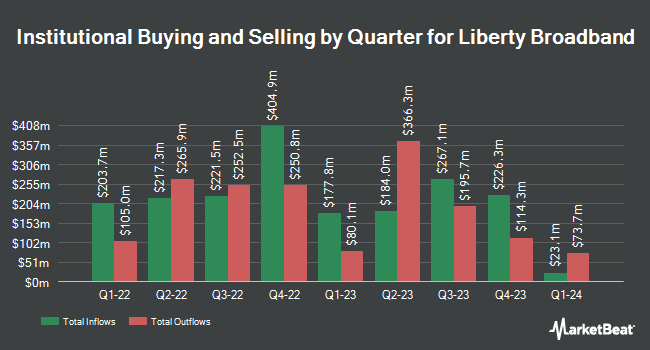Bank of Montreal Can reduced its stake in Liberty Broadband Co. (NASDAQ:LBRDK - Free Report) by 73.6% during the 4th quarter, according to the company in its most recent Form 13F filing with the Securities and Exchange Commission. The institutional investor owned 72,816 shares of the company's stock after selling 202,790 shares during the period. Bank of Montreal Can owned approximately 0.05% of Liberty Broadband worth $5,444,000 at the end of the most recent reporting period.
A number of other hedge funds and other institutional investors have also recently bought and sold shares of LBRDK. Smartleaf Asset Management LLC lifted its holdings in Liberty Broadband by 61.1% during the 4th quarter. Smartleaf Asset Management LLC now owns 406 shares of the company's stock worth $30,000 after buying an additional 154 shares during the last quarter. Blue Trust Inc. raised its position in shares of Liberty Broadband by 134.3% during the 4th quarter. Blue Trust Inc. now owns 464 shares of the company's stock worth $36,000 after acquiring an additional 266 shares in the last quarter. Jones Financial Companies Lllp lifted its stake in Liberty Broadband by 138.0% during the fourth quarter. Jones Financial Companies Lllp now owns 488 shares of the company's stock worth $36,000 after purchasing an additional 283 shares during the last quarter. Lee Danner & Bass Inc. acquired a new position in Liberty Broadband in the fourth quarter valued at approximately $36,000. Finally, R Squared Ltd purchased a new position in Liberty Broadband in the fourth quarter valued at approximately $37,000. 80.22% of the stock is currently owned by hedge funds and other institutional investors.
Analysts Set New Price Targets
Separately, StockNews.com initiated coverage on shares of Liberty Broadband in a research report on Monday, April 14th. They set a "sell" rating on the stock.
Get Our Latest Research Report on LBRDK
Liberty Broadband Stock Performance
Shares of LBRDK stock traded up $1.62 during midday trading on Friday, hitting $78.22. The company had a trading volume of 661,821 shares, compared to its average volume of 1,045,077. Liberty Broadband Co. has a 52-week low of $46.46 and a 52-week high of $101.50. The company has a debt-to-equity ratio of 0.40, a current ratio of 2.07 and a quick ratio of 2.07. The company's 50 day simple moving average is $81.68 and its 200 day simple moving average is $81.46. The stock has a market cap of $11.21 billion, a price-to-earnings ratio of 14.41 and a beta of 1.03.
Liberty Broadband (NASDAQ:LBRDK - Get Free Report) last announced its quarterly earnings data on Thursday, February 27th. The company reported $2.04 EPS for the quarter, missing analysts' consensus estimates of $3.67 by ($1.63). The firm had revenue of $253.00 million for the quarter, compared to analysts' expectations of $252.50 million. Liberty Broadband had a return on equity of 8.45% and a net margin of 78.07%. Research analysts anticipate that Liberty Broadband Co. will post 7.71 earnings per share for the current fiscal year.
Liberty Broadband Profile
(
Free Report)
Liberty Broadband Corporation engages in the communications businesses. The company's GCI Holdings segment provides data, wireless, video, voice, and managed services to residential customers, businesses, governmental entities, educational, and medical institutions in Alaska under the GCI brand.
See Also

Before you consider Liberty Broadband, you'll want to hear this.
MarketBeat keeps track of Wall Street's top-rated and best performing research analysts and the stocks they recommend to their clients on a daily basis. MarketBeat has identified the five stocks that top analysts are quietly whispering to their clients to buy now before the broader market catches on... and Liberty Broadband wasn't on the list.
While Liberty Broadband currently has a Moderate Buy rating among analysts, top-rated analysts believe these five stocks are better buys.
View The Five Stocks Here
Discover the 10 Best High-Yield Dividend Stocks for 2025 and secure reliable income in uncertain markets. Download the report now to identify top dividend payers and avoid common yield traps.
Get This Free Report
Like this article? Share it with a colleague.
Link copied to clipboard.